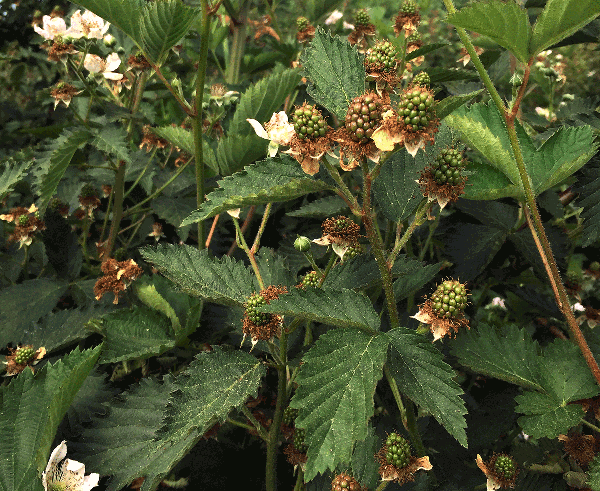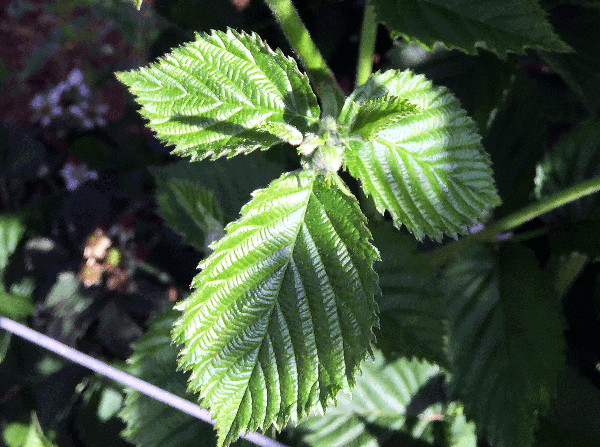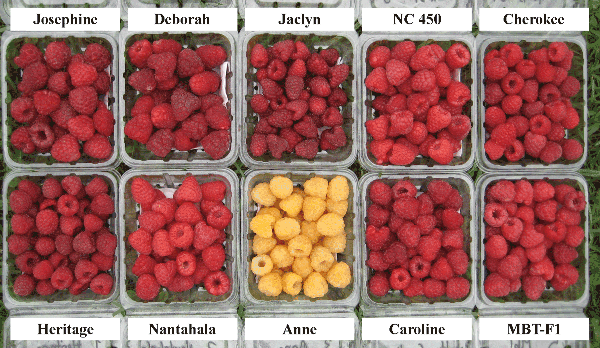The caneberry (blackberry and raspberry) industry has undergone a significant change in the southern United States in the past two decades. The development of shipping quality, fresh market blackberry cultivars, along with recognition of the health benefits associated with eating berries, has facilitated the phenomenal growth of this industry in the region. Since the late 1990s, the acreage devoted to caneberries has increased throughout the southern United States in all grower categories:
-
small-scale (less than 3-acre farms) for local and pick-your-own (PYO) sales
-
medium scale (commercial, local sales, and PYO)
-
large-scale (farms of 5 to 10 or more acres that produce fruits for wholesale marketing)
The development of raspberry cultivars by US and international breeding programs has prompted growers to investigate the possibility of local and commercial raspberry production in new regions, particularly at high elevations, with high tunnels and other seasonal extension techniques.
This guide was created to provide growers with information on plant growth and basic production practices. Pest management for caneberry growing in the southern US is available in the Southeast Regional Caneberries Integrated Management Guide, available at the Southern Region Small Fruits Consortium’s IPM/Production Guides web page. The pest management guide is updated regularly to provide up-to-date crop protectant information for growers in the southern US.
In addition, the University of Arkansas developed a “Blackberry School” that is a valuable resource of recordings and how-to videos for new growers who are learning about caneberry production.
Types of Caneberries
Caneberries are grouped by four plant characteristics:
-
growth habit (trailing, semi-erect, or erect)
-
fruiting habit (primocane or floricane)
-
presence or absence of thorns (thorny or thornless)
-
fruit color (raspberries only)
Growth Habit
There are three main types of growth habits: trailing, erect, and semi-erect (Figure 1-1). These classifications refer specifically to cane growth habit.
Canes of trailing caneberries run along the ground. Trailing blackberries, often referred to as “dewberries,” have prostrate canes, or canes that lie upon or close to the ground, that tend to produce large, early ripening fruit. Trailing raspberry varieties exist, although they are not readily available.
Erect caneberries produce stiff, upright canes that need summer and winter pruning. The erect growth habit is common in both raspberries and fresh market blackberries.
Semi-erect caneberries produce very thick, arching canes that benefit from summer and winter pruning. These varieties will start growing upright and bend over to trail along the ground if not supported. Black raspberries tend to be semi-erect and will tip root if not pruned adequately. This limits fruit production.
Growth habit determines the type of trellis support that canes require. In some regions, erect types of raspberries and blackberries do not require trellis support. In the southern US, however, blackberries and raspberries benefit from a trellis for commercial production. Support becomes essential after laterals begin producing fruit. Without adequate trellising, laterals can snap under the weight of the fruit load in windy conditions or during harvest. Fruit may also touch the ground if not trellised, which can result in the loss of salable fruit.
Fruiting Habit
Although caneberries are perennial plants, canes of blackberries and raspberries are biennial—that is, they have two-year life cycles (see Table 1-1, and Figures 1-2, 1-3a, 1-3b, and 1-4).
Floricane Fruiting
Most blackberry and some raspberry cultivars are floricane-fruiting, which means that they will bear fruit in their second and subsequent years of their life.
The first year of a cane’s growth is the primocane year. During this year, the cane will grow and initiate fruit buds in the latter part of summer to early fall.
During the second year of growth, the floricane year, primocanes from the first year are now the floricanes. The floricanes will bloom and produce fruit on lateral branches. After fruiting, the floricanes die back to the crown.
Both primocanes and floricanes exist in the planting space in the second year and every year thereafter. Some cultivars will produce a baby crop during the first year of fruiting. However, in the third and subsequent years, the planting will produce a full crop.
Primocane Fruiting
Several cultivars of red and yellow raspberries and some blackberries are primocane-fruiting, which means that they will bear fruit during the cane’s first year of growth. These cultivars are referred to as “primocane-fruiting,” “ever-bearing,” or “fall-bearing.” The upper one-third to one-half of the primocane will bear fruit beginning in late summer and continue producing into fall, and typically up until the first freeze. Some growers use high tunnels to extend the harvest season.
If the cane is retained for the floricane year, fruiting will occur on the part of the cane that did not bear fruit in the fall.
Thorniness
Thorny and thornless cultivars are available for both primocane and floricane-fruiting types of caneberries. Most commercial blackberry growers in the South plant thornless cultivars because they are easier to manage. Most raspberry cultivars adapted to the southern US have thorns, although the thorns are not as large as blackberry thorns and are not a significant impediment during harvest or pruning.
From a botanical perspective, what we commonly call thorns are actually prickles. Thorns are modified branches, and spines are modified leaves. Both contain vascular tissue. Prickles, on the other hand, are part of the epidermis and do not contain vascular tissue. (See further technical explanation on YouTube Thorns, spines, and prickles).
Fruit Color (Raspberries)
Raspberries can produce red, yellow, purple, or black fruits (Figure 1-5). Red raspberries are by far the most common type and, in general, are the most widely adapted for commercial production. Yellow and purple raspberries are not recommended for commercial production because available cultivars are highly perishable and do not produce high yields. Black raspberries grow best in the cooler parts of the region and are suited for home production.
Publication date: Feb. 23, 2023
AG-697
Other Publications in Southeast Regional Caneberry Production Guide
- Introduction
- Cultivars
- Site Selection
- Site Preparation, Planting, and Establishment
- Plant Growth
- Pruning and Training
- Trellis Systems
- Tunnel Production
- Water Management
- Integrated Pest Management and Pollination
- Fertility Management
- Fruit Development
- Harvesting and Postharvest Management
- Food Safety Considerations for Caneberry Production
N.C. Cooperative Extension prohibits discrimination and harassment regardless of age, color, disability, family and marital status, gender identity, national origin, political beliefs, race, religion, sex (including pregnancy), sexual orientation and veteran status.






